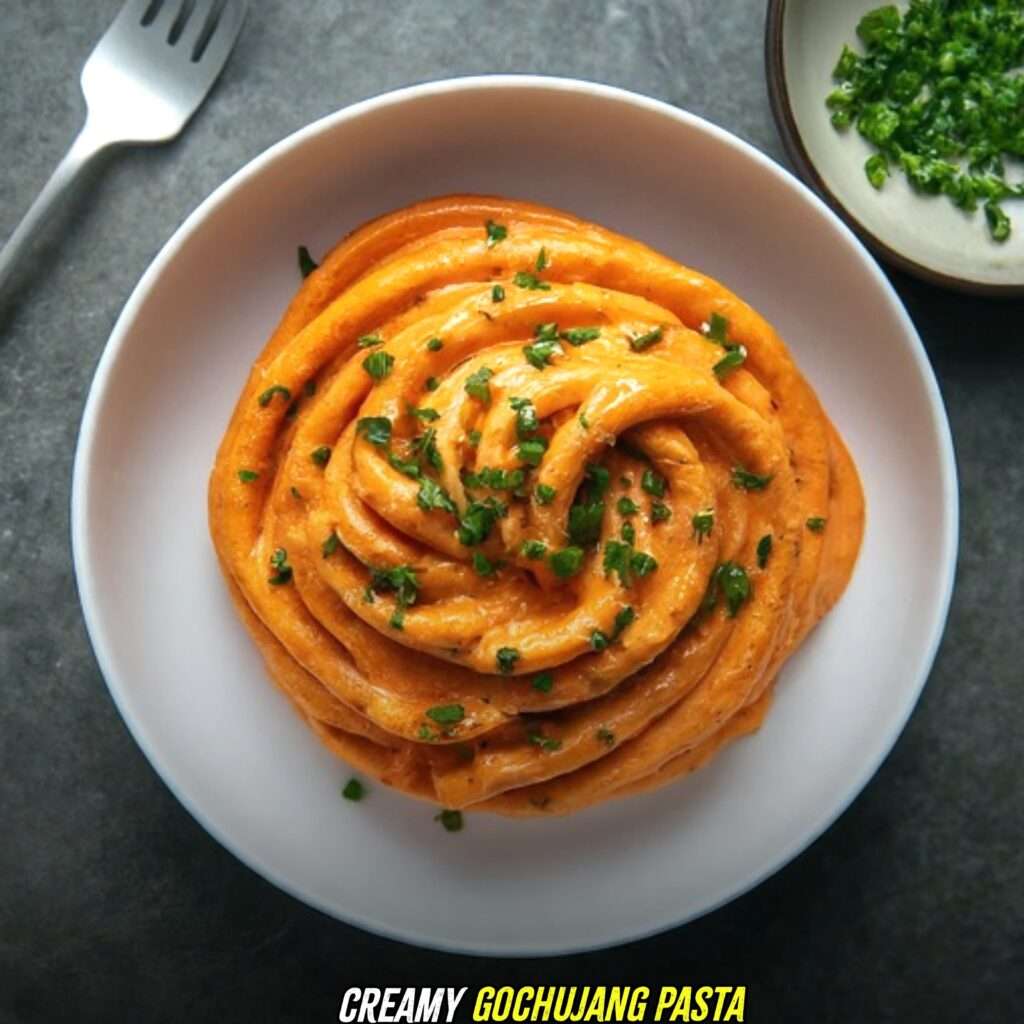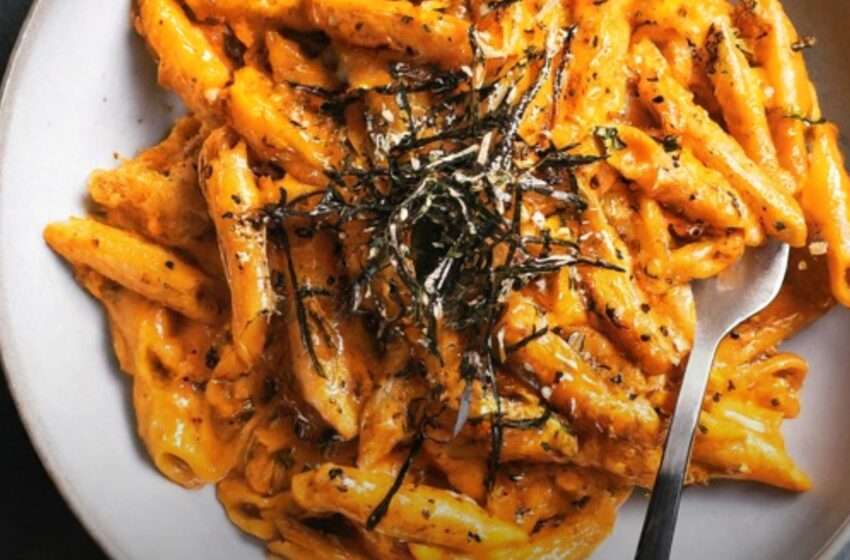I want you to take a tasty adventure with an easy dish that will elevate your overall taste – try the gochujang pasta recipe.
In this blog post, we will discuss the complete process of preparation of gochujang pasta. Later, we will also look at variations, pro tips to level up the taste, storage and freezing tips and much more.
What is Gochujang Pasta?
Gochujang Pasta is a fusion dish that mixes Italian pasta with Korean taste. It contains gochujang, which is a spicy chilli paste from Korea.
The pasta is cooked and mixed with a sauce prepared with gochujang, soy sauce, garlic, veggies, sesame oil and meat like shrimp or chicken. It results in a tangy, spicy and flavorful pasta dish with a unique twist.
Gochujang Pasta Recipe Tips
- Adjust the Spiciness: You can choose the gochujang paste of your personal brand and start with a little bit, then add more if you want it more spicy.

- Cook the right pasta: You can choose any pasta but long noodles like linguine or spaghetti work well as they hold the sauce well.

- Prepare Ingredients in Advance: Make sure to prepare the ingredients in advance along with the protein you want to add. It will make the cooking easier and ensure everything is ready when you use it.

- Don’t overcook the vegetables: Stir-fry the vegetables until crispy and tender. Overcooking can make them mushy and lose their bright colours and flavours.

- Balance Flavors: Taste the sauce before pouring it into the pasta and adjust the seasoning as required. You may need to add sesame oil for nuttiness, soy sauce for saltiness and a bit of sugar or honey for balancing the spiciness.

Variations
- Creamy Gochujang Pasta: You can make a creamy dish by adding coconut milk or heavy cream to the gochujang sauce. It makes it rich and smooth which balances the spiciness of the gochujang.

- Gochujang Carbonara: You can prepare a new version of carbonara by including the gochujang in the sauce with pancetta or bacon, parmesan cheese and eggs.

- Seafood Gochujang Pasta: You can improve the dish by adding seafood like scallops, shrimp or squid. You just need to cook the seafood with garlic and olive oil in a pan, then mix it with gochujang sauce and cooked pasta.

- Vegetarian Gochujang Pasta: For a vegetarian option, you can include use mushrooms, zucchini or cherry tomatoes. You can also use tempeh or tofu for plant-oriented protein.

- Gochujang Mac and Cheese: You can prepare a special mac and cheese Korean style by adding the gochujang to the cheese sauce. Then, bake it with breadcrumbs on top for a crunchy twist.

What to Serve
- Kimchi: You can serve the Korean kimchi on the side. The spicy and tangy flavour of the kimchi works well with the gochujang pasta which gives a refreshing contrast.

- Asian Claw: You can make Asian claw with shredded cabbage, bell peppers, carrots, and sesame-ginger dressing. The bright flavour and crisp texture of the slaw work well with the spicy pasta.

- Pickled Vegetables: You can also serve pickled vegetables like pickled radish, cucumbers or daikon for a tangy and crispy meal.

- Miso Soup: You can also serve miso soup with gochujang pasta. It contains a delicious savoury flavour that works with the strong flavour of the pasta.

Storing and freezing
Storing
- If you are planning to store the pasta within a few days, you can put it in an air-tight container in the refrigerator. It can last up to 3-5 days.
- Sometimes, pasta with the sauce may become lumpy when stored. To avoid this mix the pasta with the sauce before serving.
- Make sure to go with a container with a tight-fitting lid to prevent air from entering. It prevents the pasta from drying out.
Freezing
- Let the pasta cool completely before freezing.
- You can also portion the pasta into each serving before freezing.
- Use freezer bags or air-tight containers for optimal storage. Eliminate as much air as possible to avoid freezer burn.
- Make sure to label the container or the bags with the date to keep track of the freshness.
Conclusion
In conclusion, trying the gochujang pasta recipe provides an enriching and delightful experience. We had fun with spicy gochujang paste and tried it in different ways. The paste makes the pasta taste better by adding depth and a hint of spicy sweetness.
So, next time you are craving a pasta dish, you can explore different versions of gochujang. It contains a special flavour that you can use in several dishes.
Read More:- Pasta House Salad Recipe

Gochujang Pasta Recipe
Ingredients
- 8 ounces of pasta spaghetti, linguine, or any pasta of your choice
- 2 tablespoons of gochujang paste
- 2 tablespoons of soy sauce
- 2 tablespoons of sesame oil
- 2 cloves of garlic minced
- 1 tablespoon of vegetable oil
- 1 cup of mixed vegetables bell peppers, carrots, broccoli, etc., chopped
- Optional: protein of your choice chicken, tofu, shrimp, etc., cooked and sliced
- Optional garnishes: sesame seeds sliced green onions
Instructions
- First of all, cook the pasta as per the instructions of the package until it is firm. Then, drian and keep it aside.
- In a little bowl, add soy sauce, gochujang paste and sesame oil to prepare the sauce. You can also adjust the level of gochujang paste as per your desired level.
- Over the medium heat, heat the vegetable oil in a large skillet. Add minced garlic and cook for around a minute until smells nice.
- Now include the mixed vegetables to the skillet and stir-fry for around 3-4 minutes until crispy and tender.
- If you are using the cooked protein add it to the skillet and cook until heated through.
- Then, add the cooked pasta and pour over the gochujang sauce. Mix everything thoroughly until the pasta is evenly coated.
- Cook the mixture for more 1-2 minutes, until everything is heated through.
- It’s time to serve the gochujang pasta. You can also garnish it with sliced green onion or sesame seeds.


